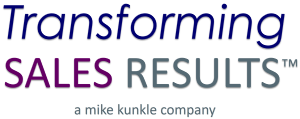How to Build a Blended Sales Training Curriculum That Gets Results
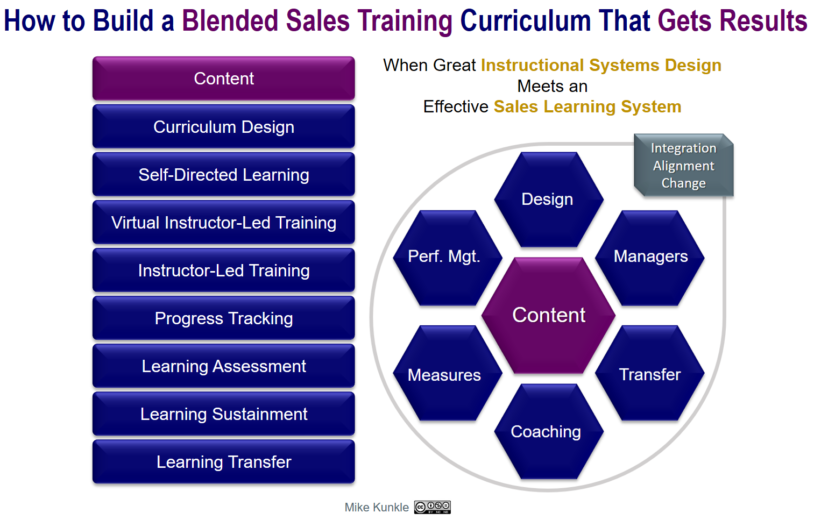
Sales training can be part of a well-designed solution set that radically improves sales performance. It can also be a tremendous waste of time, energy, and money. To get results, you need to implement sales training within the framework of an Sales Learning System, which I’ve written about previously. In this post, I’ll offer ideas about how to use blended learning strategies supported by a learning system.
The Learning Blender
Let’s start by defining “blended learning.”
The smart folks at Mindflash say that blended learning is “a term increasingly used to describe the way elearning is being combined with traditional classroom methods and independent study to create a new, hybrid teaching methodology,”and the bright folks at Knewton have created this cool infographic that you might enjoy.
In many cases when you’re discussing blended learning, the concept of the flipped classroom comes up. If you’re familiar with the Khan Academy, that’s a flipped model. ATD published a post called Flipped Learning: Maximizing Face Time and Knewton has another cool infographic on the flipped classroom, too. I was doing flipped classrooms as far back as 2003 and am a strong advocate of the model, as you’ll see in this post.
At this point, we can also start tossing around terms like synchronous, asynchronous, social learning, informal learning, and mentioning education management tools and web collaboration and virtual training environments, or we can stop worrrying about concepts and tools, and start talking about practical methods to develop a blended learning strategy that can improve sales results.
I’m going for the latter.
For the purpose of this post, I’m going to define blended learning this way:
“Blended learning is a mix of online, classroom, self-directed, and instructor-guided learning methods, interwoven purposefully, with the ultimate goal of achieving pre-determined learning and performance objectives.”
A Few More Words about Sales Learning Systems
It’s impossible (for me, at least) to talk about designing effective blended learning curricula in a vacuum, without a systems approach, or in this case, a Sales Learning System.
The Sales Learning System Framework
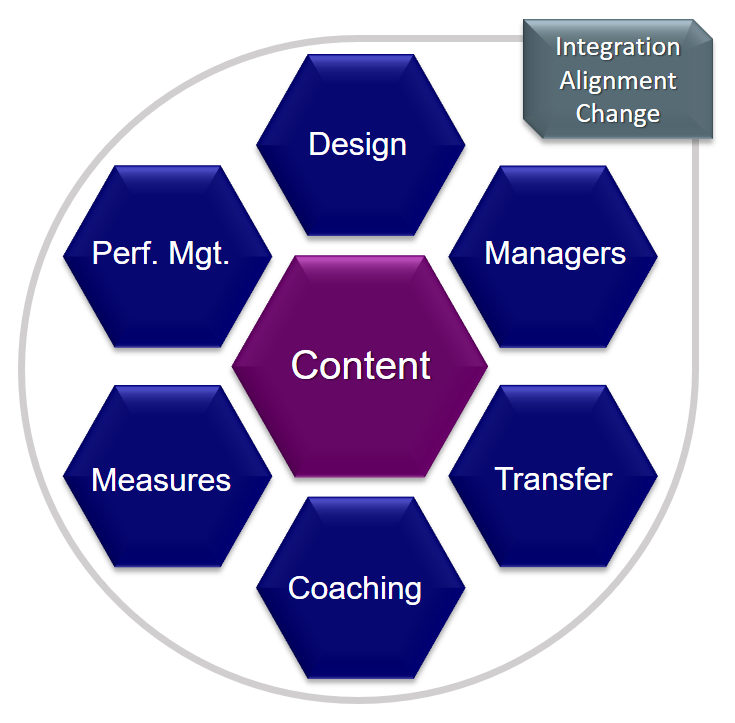
I’ve written about this concept and my framework multiple times. Most recently here, and you can see more here and here. Most of the design of effective blended learning curricula falls into the Design bucket of the Sales Learning System Framework.
Overview of Effective Blended Learning Principles
There are some key principles and practices that I’ve used over the years that you might find helpful. I’ll list them here and then share some detail about each.
Blended Learning Principles & Practices (mapped to the SLS)
- Ensure theC
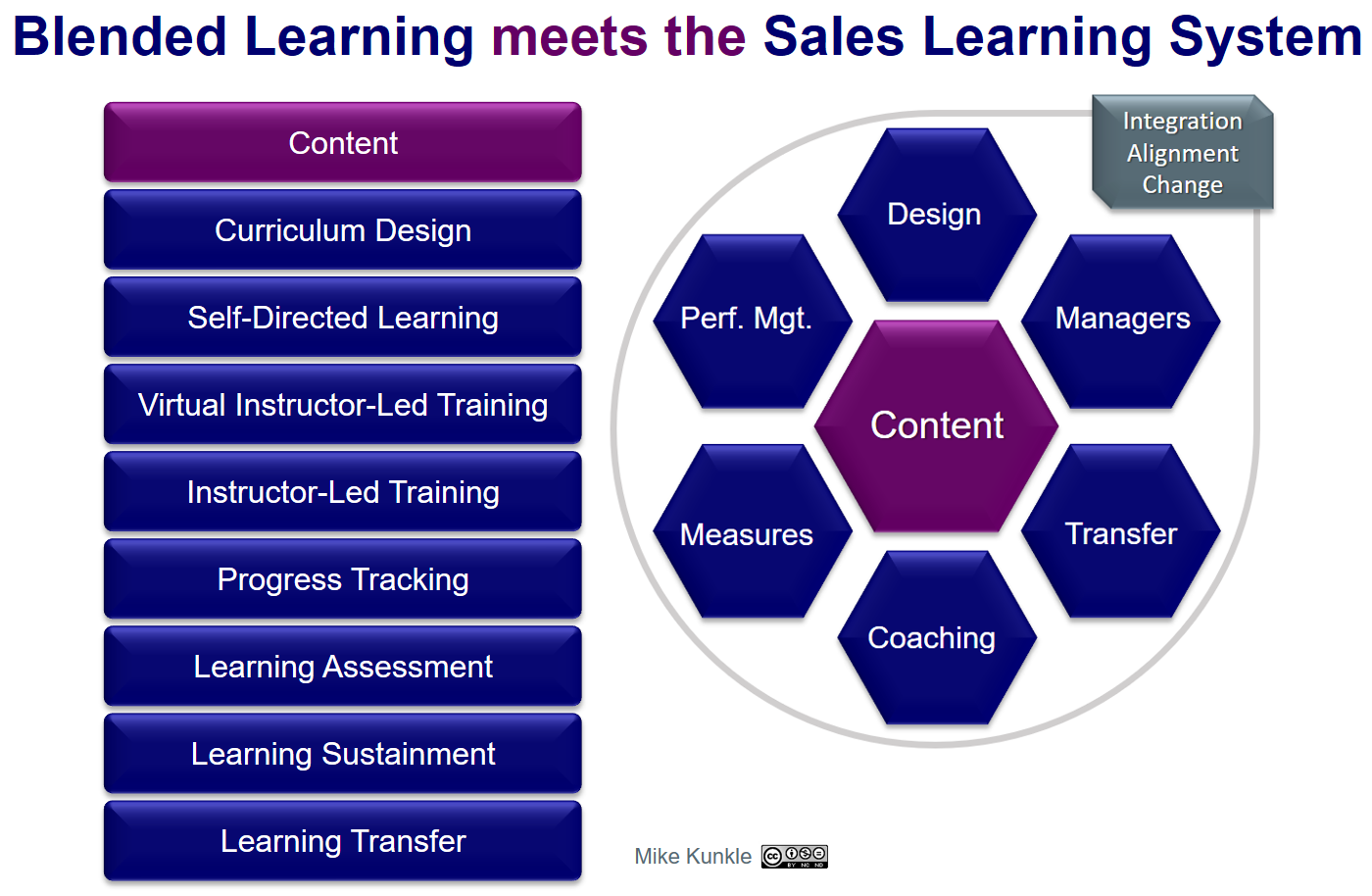 ontent in the blended curriculum matters (in the SLS: maps to Content)
ontent in the blended curriculum matters (in the SLS: maps to Content) - Have a sound Curriculum Design strategy (maps to SLS: Design)
- Use Self-Directed Learning (elearning) effectively (maps to SLS: Design)
- Use Virtual Instructor-Led Training (vILT) effectively (maps to SLS: Design)
- Use classroom-based, Instructor-Led Training (ILT) effectively (maps to SLS: Design)
- Track Progress (maps to SLS: Design and Measures)
- Assess learning (maps to SLS: Design and Measures)
- Sustain learning (maps to SLS: Managers, Transfer, Coaching, Performance Management)
- Build in accountability for Learning Transfer (maps to SLS: Design, Transfer, Coaching)
This is how you can make the connection between the blended learning design and the Sales Learning System (SLS). In reality, the content, sustainment and transfer pieces, are really SLS elements, more so than blended curriculum principles. In my mind, though, they’re not mutually exclusive, and even though a blended curriculum lives inside an SLS in Design, the curriculum needs to include and reinforce the SLS elements. The dots are interconnected.
Now, let’s look at each blended curriculum element and how it maps to the learning system in more detail.
Ensuring the Content Matters
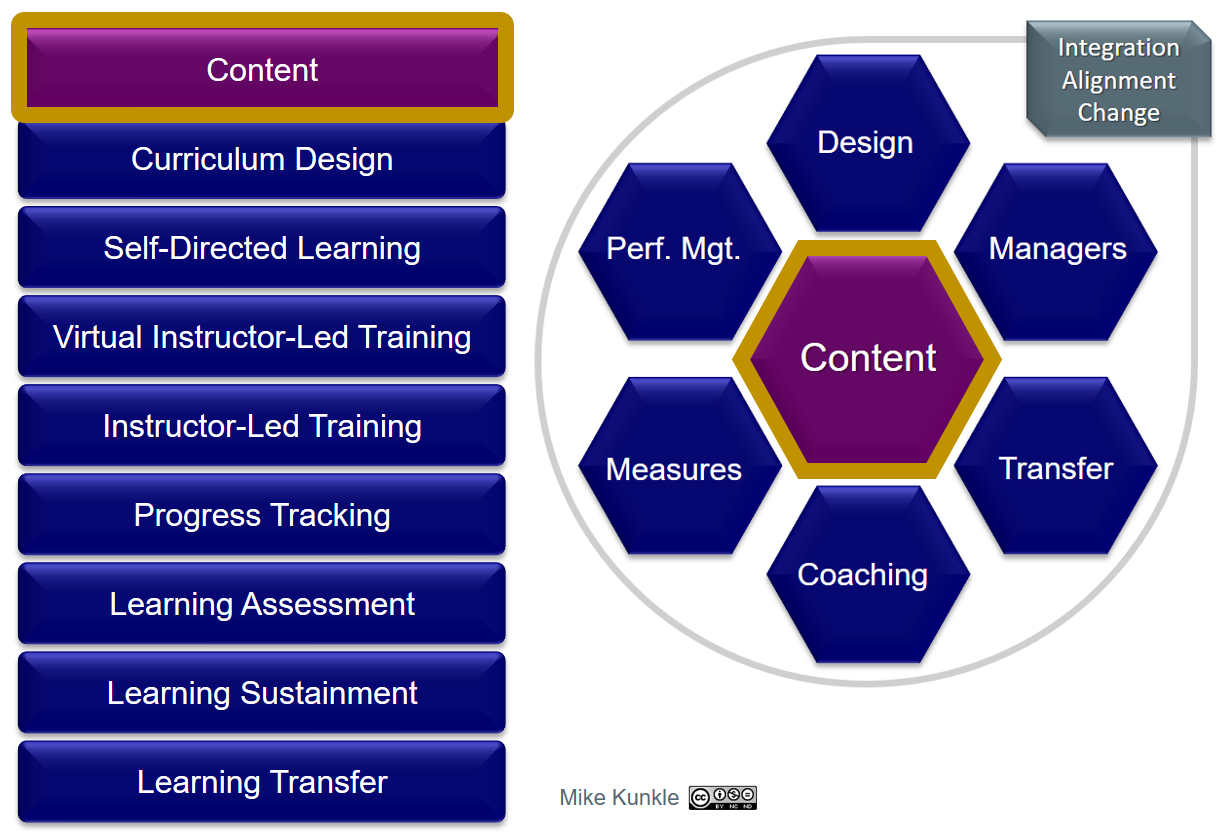
I won’t belabor this much more, because it’s not the point of this post, but in any Effective Learning System, especially for sales, you must start with the right content that matters and will close gaps between average and top performance. This isn’t specific to a blended learning approach but is important enough to mention. It’s a fairly universal challenge, but can attest that it’s especially truefor sales training, and a reason that some sales training doesn’t produce results, no matter how well it’s taught or reinforced. Get the content right, or don’t bother training.
Additional reading:
- http://blogs.richardson.com/2013/08/05/which-top-producers-should-you-study-to-develop-sales-training-programs/
- https://www.mikekunkle.com/2013/03/17/how-to-increase-sales-with-top-producer-practices-part1/
- https://www.mikekunkle.com/2013/03/20/how-to-increase-sales-with-top-producer-research-part-2/
- https://www.mikekunkle.com/2014/07/30/stop-wasting-money-on-sales-training/
Having a Sound Curriculum Strategy
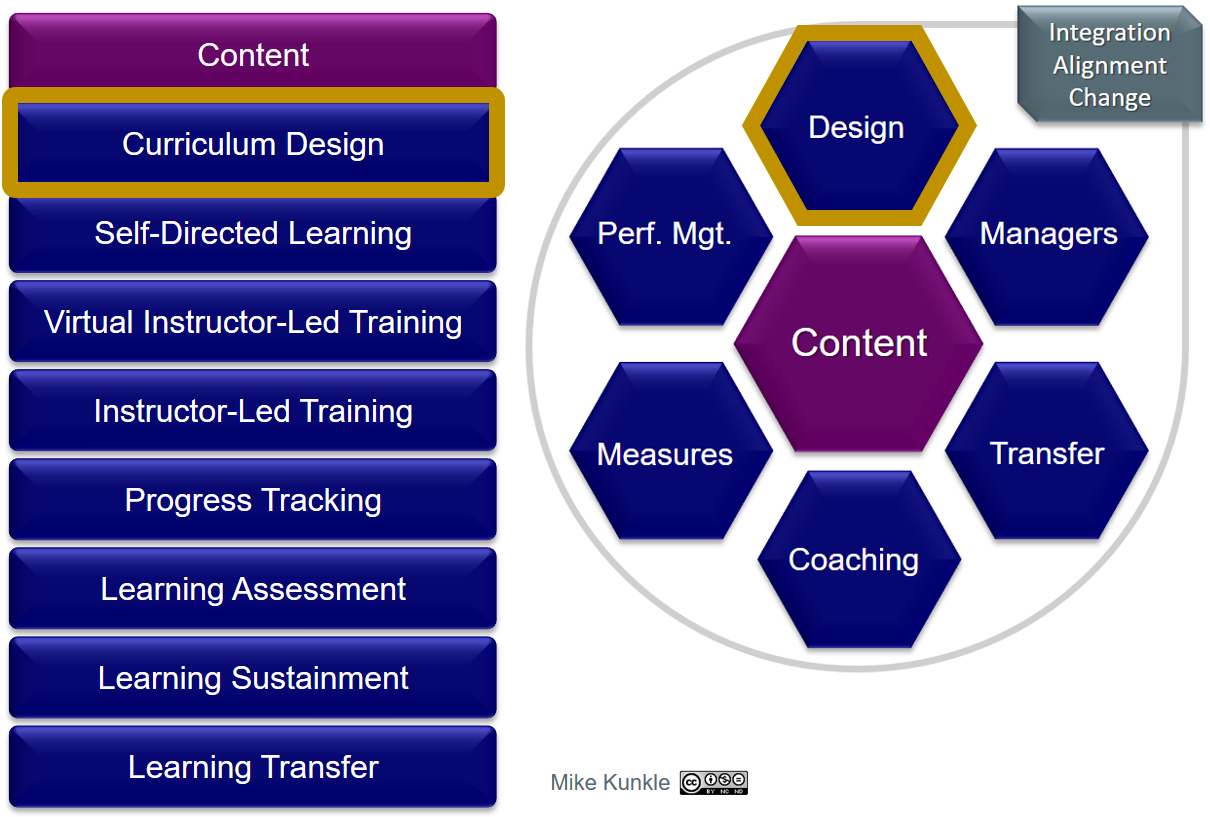
I favor using the simple, logical, and powerful instructional design concept of chunking, sequencing, and layering content to arrange and teach content effectively.
- Chunking is putting like content together and doing it in bite-sized chunks that people can absorb and learn.
- Sequencing is teaching it in an order than makes logical sense.
- Layering is doing the same again, on top of something that was well-learned, to continue the learning journey.
You can apply these principles to the design of one course or the design of a curriculum. This is not specific to blended learning. This is a foundation of well-designed training in general. Obviously I’m over-simplifying, but to me, this is one of those 20 percent things, that can produce 80 percent of your results. Build training based on great learning objectives and content that close identified performance gaps, and chunk, sequence and layer your content appropriately, and you will far more effective than most.
There are notable exceptions, of course, but by and large, I’ve been disappointed by the curricula planning I’ve seen in corporate training endeavors. We can do better. We all seem to know about analysis (needs, task and gap analysis), defining competencies, creating learning objectives, and designing training effectively… but for various reasons (time, budget, resources, shifting priorities, short-term focus, and unrealistic expectations), we often find ourselves doing things differently than we know will produce results. If you want value from a sales curriculum or a blended learning strategy, you simply can’t slam it together or ignore basic principles, and expect great results.
I share some principles you might find helpful in this SlideShare presentation on basic instructional design principles, and in this deck on effective sales onboarding.
Additional reading:
- http://thevirtualpresenter.com/case-studies/redesigning-sales-training-interview-with-mike-kunkle/
- http://www.nwlink.com/~donclark/hrd/learning/id/elaboration_theory.html
- http://www.nwlink.com/~donclark/hrd/learning_environment_framework.html
Using Self-directed elearning Effectively
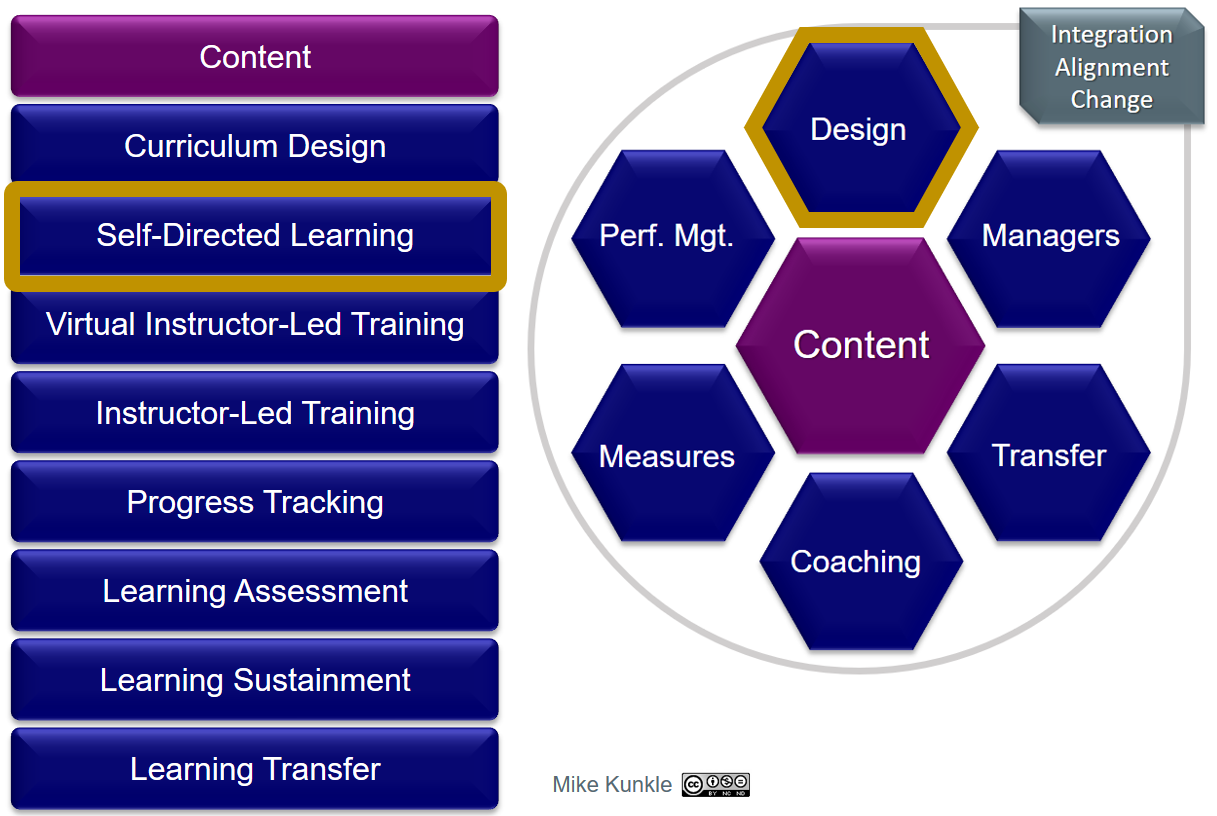
Elearning works very well for transferring knowledge such as terms, concepts, frameworks, and models, for providing scenarios and simulations where learners can use judgment to select the correct responses (the precursor to developing skills), and for teaching what, why, when, where (knowledge and judgment) as well as the knowledge of how to do something.
Through video and other demonstration methods, elearning can be used to provide good and poor examples of skills. It’s also an excellent means for teaching some skills, such as using a computer or software.
The great elearning skill debate: This may cause a stir with some of my elearning-advocate friends, but I do not personally believe elearning is the best selection for honing interpersonal skills such as selling or communication skills. This is my opinion based on my experiences, and there are those who disagree with me. If you’re one of them, I’d enjoy the debate.
With the use of scenarios, simulations, videos, and by providing feedback, it’s close and getting better all the time. But in my experience, without live practice in a very real-world, simulated environment with human observation, feedback/coaching, and reapplication of skills with a chance to apply the feedback and receive additional coaching, I don’t think self-directed elearning offers enough horsepower to develop interpersonal skills, especially complex selling skills mastery.
It can, however, allow you to significantly shorten expensive classroom or vILT times, better prepare learners, radically reduce lecture, and flip your classrooms into true application sessions with coaching, feedback and more practice than ever. THIS, to me, is the real power of elearning in the blended curriculum.
By the way, for those who aren’t in the learning and development field, there may be more options here than you’re aware of. Self-directed elearning can include:
- Very professional and slick-looking, full-featured, internally- or vendor-developed elearning courses, with audio, slides, video, graphics, branching (“if this, then that” course sequencing), quizzes and assessments (if upfront, test results will determine which modules are necessary and which you’ve tested out of) and more.
- Basic elearning courses that are like an automated PowerPoint presentation, with or without audio, likely with the “Next” buttons you’ve seen or DVR-like controls, and possibly with quizzes and assessments.
- Watching brief recorded presentations or best practice videos.
- Online reading, watching other videos, listening to audio recordings or podcasts, taking online assessments.
- Online explorations (such as research assignments, scavenger hunts, site reviews).
- Participating in an online discussion, commenting on a wiki, posting on social community, answering questions posted by others of an instructor, or more.
Additional reading:
- http://blog.cathy-moore.com/resources/elearning-samples/
- http://www.articulate.com/rapid-elearning/why-e-learning-is-so-effective/
- http://www.kineo.com/us/resources/new-to-elearning/the-benefits-of-elearning
- http://www.instructionaldesignexpert.com/eLearning.html
- http://elearningindustry.com/benefits-of-synchronous-and-asynchronous-e-learning
Using Virtual Instructor-led Training Effectively
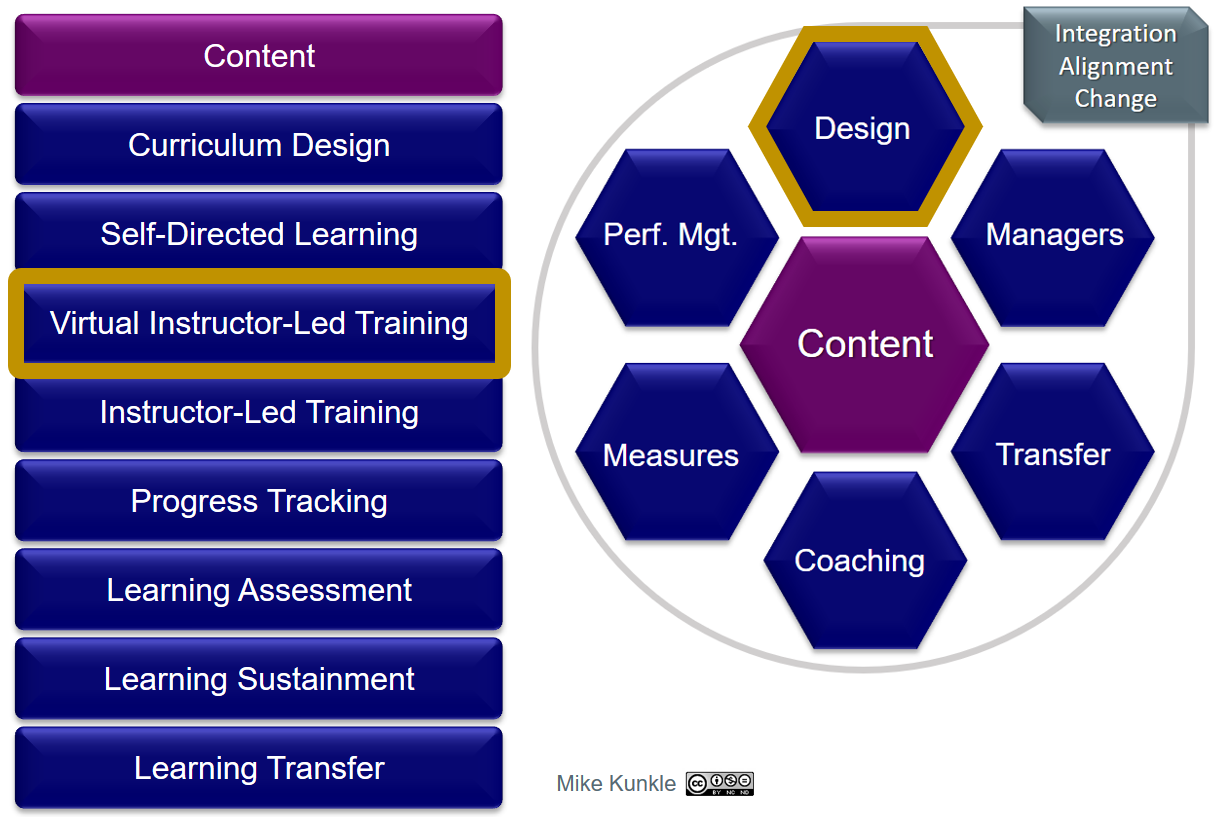
Virtual instructor-led training (vILT) works well for the same things as self-directed elearning (but is overkill for some things than can be learned without an instructor). It also excels for validating knowledge transfer, teaching knowledge and concepts that are more complex and require dialogue or facilitated discussion, for preparation for classroom-based instructor-led training (ILT) learning activities, and in some virtual learning environments with video, webcam, recording or break-out room capabilities, for skill practice and feedback.
The limits here are set only by the limits of the tools available or that you use and your creativity. Yes, most people do boring vILT, and rarely maximize the tool features that they do have, but that doesn’t need to be you. Explore the market, explore the features, and even if you can’t have the latest, brightest, shiniest new toy, do your best to maximize the features you have and keep things engaging and active.
Having said that, in one of my most effective blended curricula, we used just the most basic features of vILT (circa 2003 with WebEx) to help learners use the knowledge they gained from self-directed elearning to prepare for activities, exercises, and role plays/simulations that they would perform in their upcoming ILT class. When we didn’t need visuals, the whiteboard, polling or chat features, we also had some regular conference calls, to answer questions and review and coach on the exercise prep. It was very effective.
In one case where we were training new sales reps, they were distributed across the country and our daily (or twice-daily) virtual sessions allowed us to touch base personally, build a sense of community, keep new remote employees from feeling disconnected or overwhelmed, and offer support as needed. We often followed up one-on-one, as needed, but the group sessions helped for a positive and fun group dynamic, as well, which carried through to the ILT, where it always felt as if we all already knew each other.
Additional reading:
- http://store.astd.org/Default.aspx?tabid=167&ProductId=25280
- http://thevirtualpresenter.com/case-studies/redesigning-sales-training-interview-with-mike-kunkle/
- http://elearningindustry.com/benefits-of-synchronous-and-asynchronous-e-learning
- http://www.learningsolutionsmag.com/articles/266/four-steps-to-effective-virtual-classroom-training
- http://www.insynctraining.com/course-information/?course=5
Using Classroom-based, Instructor-led Training Effectively
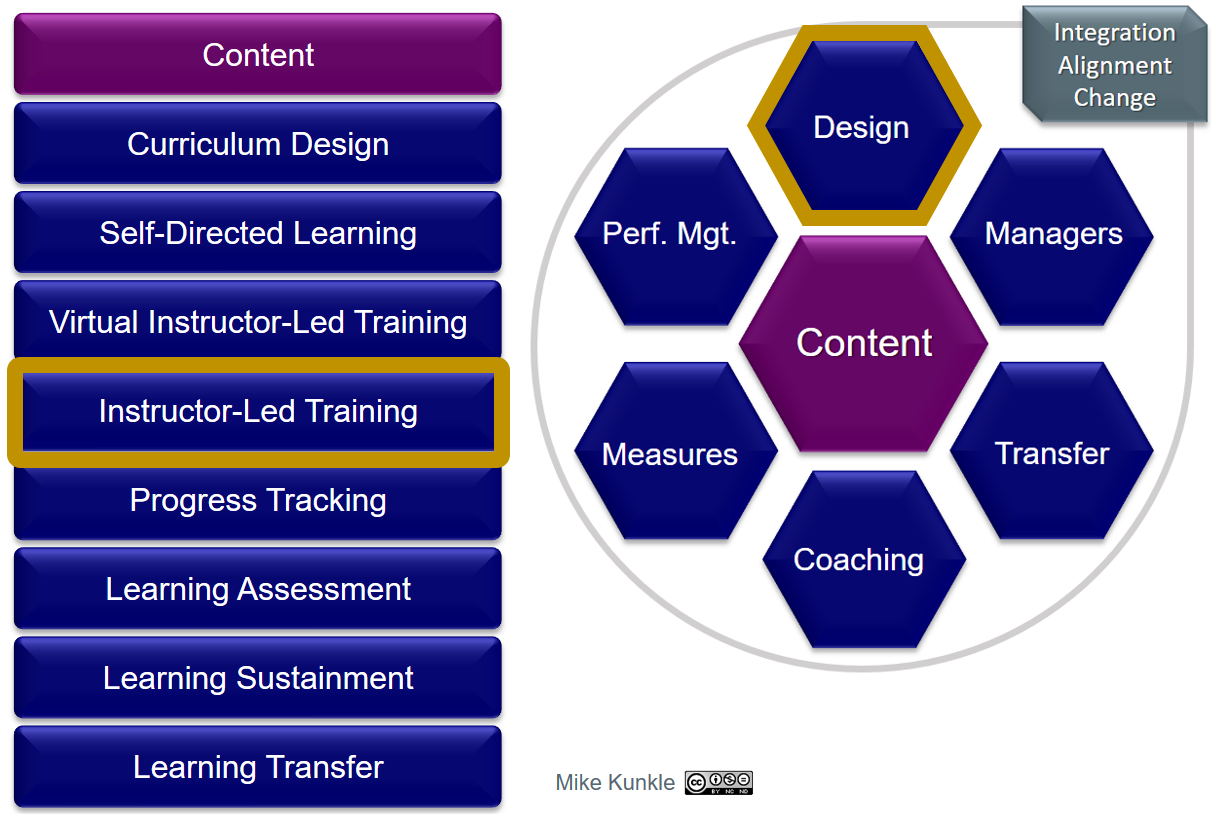 Often, in my work, this is the culmination or the apex of the learning events, where the learners really put what they learned to use, in a safe yet challenging environment that is focused on developing as much mastery as possible in the time available. As a very common form of training today, this probably requires less detail than the others, but the blended approach and flipped classroom methods do offer an advantage to radically change how classroom learning is conducted.
Often, in my work, this is the culmination or the apex of the learning events, where the learners really put what they learned to use, in a safe yet challenging environment that is focused on developing as much mastery as possible in the time available. As a very common form of training today, this probably requires less detail than the others, but the blended approach and flipped classroom methods do offer an advantage to radically change how classroom learning is conducted.
Often, even without the blended methods, classroom learning can be conducted much differently than it usually is, with more activity, facilitation, debriefing, and engagement. When you factor in the blended curriculum concepts we’re discussing here, the classroom experience can truly be transformed.
In my best examples, there was no real lecture required. Content had been taught and learned, assessed, validated, reinforced, and exercises prepared. Plus, people already knew each other. While there was always some level of deeper intros and ice breakers with agenda setting and housekeeping, things moved into action quickly. There was an introduction to an activity, which people had already prepped for, and then there was an active learning experience, most often with observation, feedback, coaching, and a chance to apply the feedback – using the skills again and getting more feedback.
Additional reading:
- http://store.astd.org/Default.aspx?tabid=167&ProductId=8042
- https://www.linkedin.com/pulse/article/20140505144436-29554219-sales-training-role-plays-done-right-can-play-a-key-part
- http://trainingtoday.blr.com/employee-training-resources/How-Conduct-Effective-Training-Session
- http://www.mindtools.com/pages/article/instructor-led-training.htm
- http://www.mindtools.com/CommSkll/HeronsCategories.htm
Tracking Progress
![]()
If you’re in the learning profession, this is old news but for others, if you have a learning management system (LMS), you can use it your to track and validate course completions. If you use assessments (discussed below), the validation of knowledge if more important than course completion, but your LMS does track courses started and completed, as well as assessment data, and there is value in having the data. It’s also easy to produce from an LMS. The learning, however, is the most important measurement.
If you’re moving toward using social learning, creating learning, support or knowledge-sharing communities, and informal learning, you’ll want to look into TinCan API (the Experience API or xAPI), if you haven’t already.
Additional reading:
- http://blog.talentlms.com/how-to-use-lms-for-performance-support/
- http://www.proprofs.com/c/category/lms/
Assessing Learning
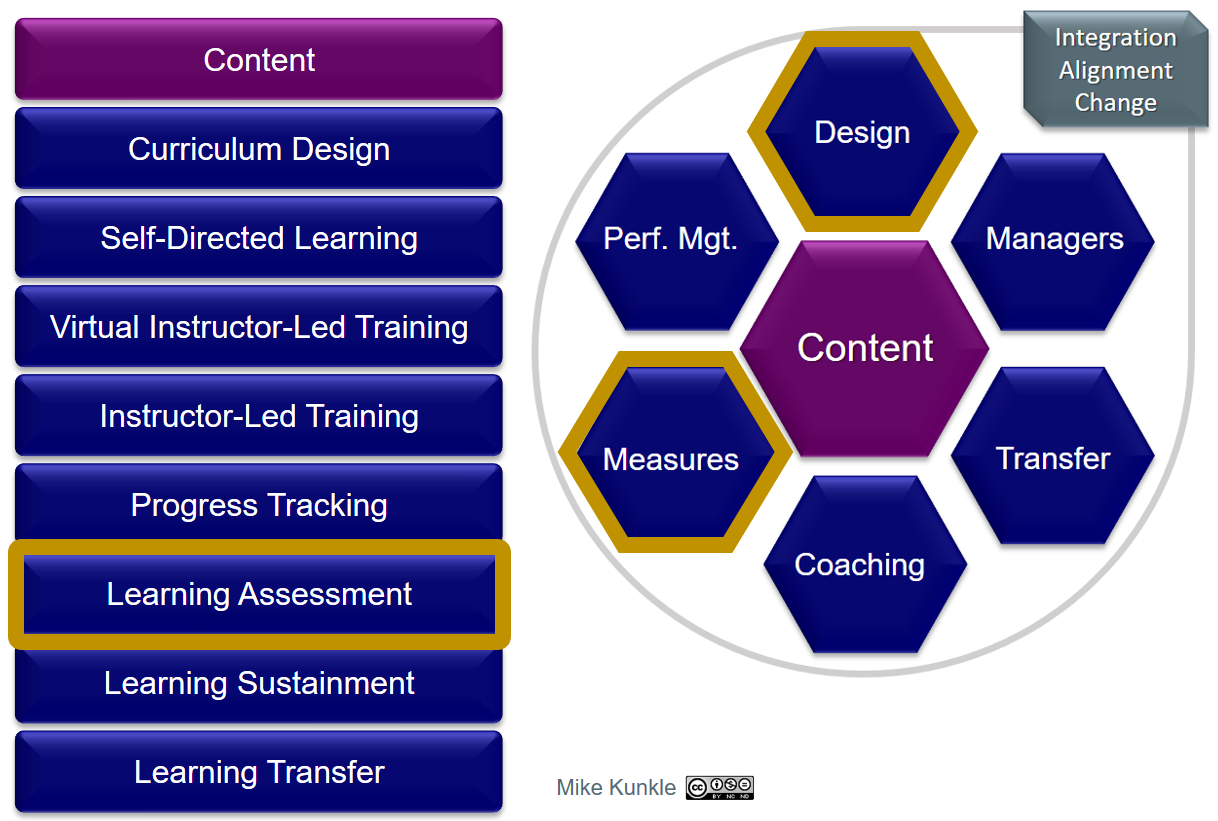
Use assessments (well-designed knowledge tests) to validate learning occurred and ensure learners are ready for the next sequence of chunked content, which can now be layered on top of what was already learned (chuck, sequence, and layer). If you’ve gone to the trouble of properly chunking, sequencing and layering the learning experience, there is little sense in moving forward with linked content that builds, if the foundation isn’t understood. From a developmental and coaching perspective, it’s helpful in pointing out to what degree various learners understand the content, who needs additional private support, and who may be able to help or mentor others (community and peer support can be very powerful and is generally helpful for both mentors and mentees).
In many of the curricula I’ve designed, I’ve tested the same content multiple times… during learning, right after learning (post-course), and later, sometimes in subsequent courses, to ensure content stuck and that you can layer on top of it. I use review in the same way. If you sequence courses properly, you can do brief reviews of previous and prerequisite content in the follow-up courses, as well. This can create scalability and edit/revision challenges in a curriculum, so I’d only do it for the most critical foundation content where the information needs to remain in memory, be used frequently, and is important to performance, but it is effective. Providing various types of memory aids, and performance support can also be helpful.
While we’re on this topic, you can also use course assessments as pre-test tools, either to show pre- and post-course knowledge differences, or allow learners to “test out” of modules or entire courses, if they already know the content.
Additional reading:
- https://www.questionmark.com/us/whitepapers/Pages/default.aspx
- http://www.k-state.edu/ksde/alp/resources/Handout-Module6.pdf
- http://www.iub.edu/~best/pdf_docs/better_tests.pdf
Sustaining Learning
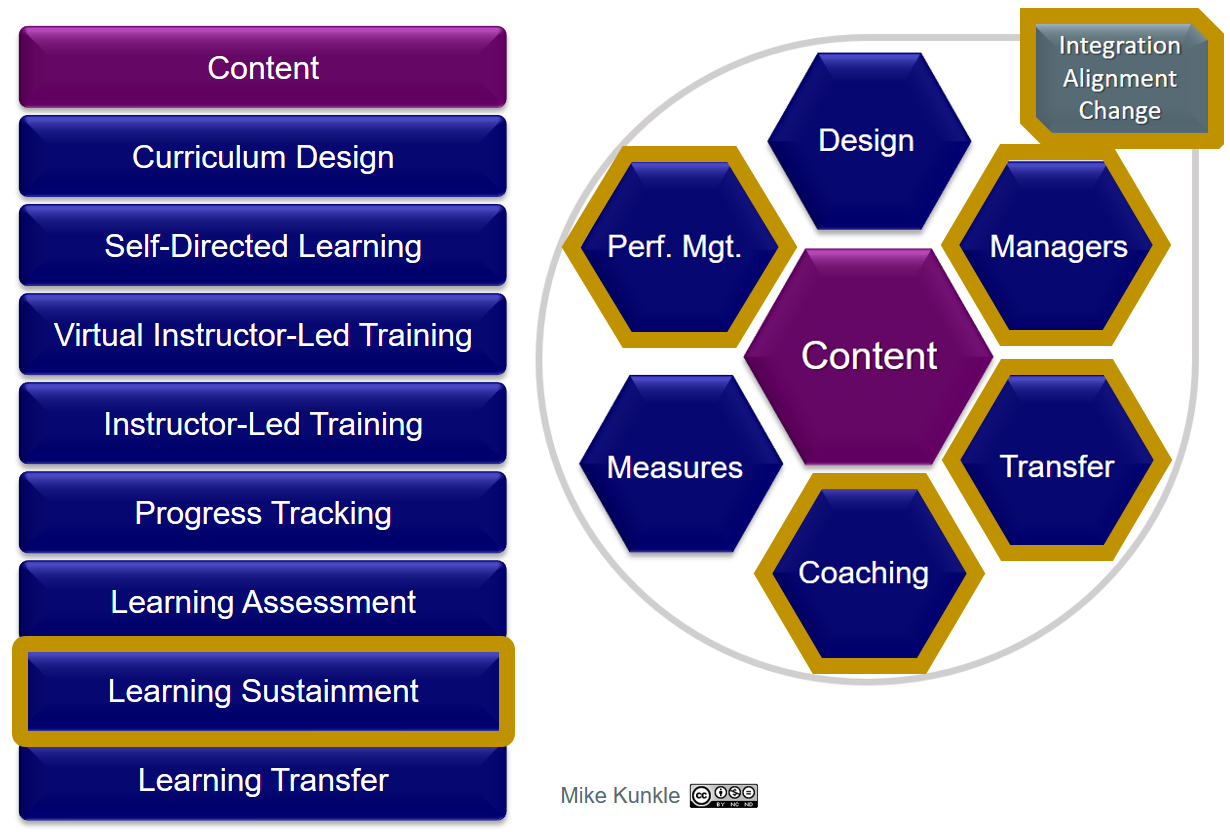
I used to do this solely through the above assessment techniques (before, during and after training) and post-training manager involvement (all still valid), but today, there are also tools such as count5’s Q MINDshare, Qstream, Axonify, Mindsetter, Mindmarker, and others that allow you to reinforce and sustain content in more effective ways. There are other sales enablement tools (including CRM) in which you can embed what you teach into workflow. I’d encourage the development of a sustainment strategy for your most critical content, both within a curriculum and afterward. And I would highly encourage embedding your best practices into a workflow support tool, such as Revegy or others.
Additional reading:
- http://www.trainingindustry.com/training-outsourcing/products/research/strategies-for-sustaining-the-impact-of-sales-training.aspx
- http://www.salesforce.com/sales-cloud/workflow-process-software.jsp
- http://www.richardson.com/What-We-Do/Continuous-Learning/Sales-Process-Pro-For-Richardson/
- http://www.savogroup.com/assets/2014/05/SAVO-Sales-Process-Pro-Ebook-Executive-Summary.pdf
- http://smartsellingtools.com/portfolio-items/revegy/
Building in Accountability for Transfer
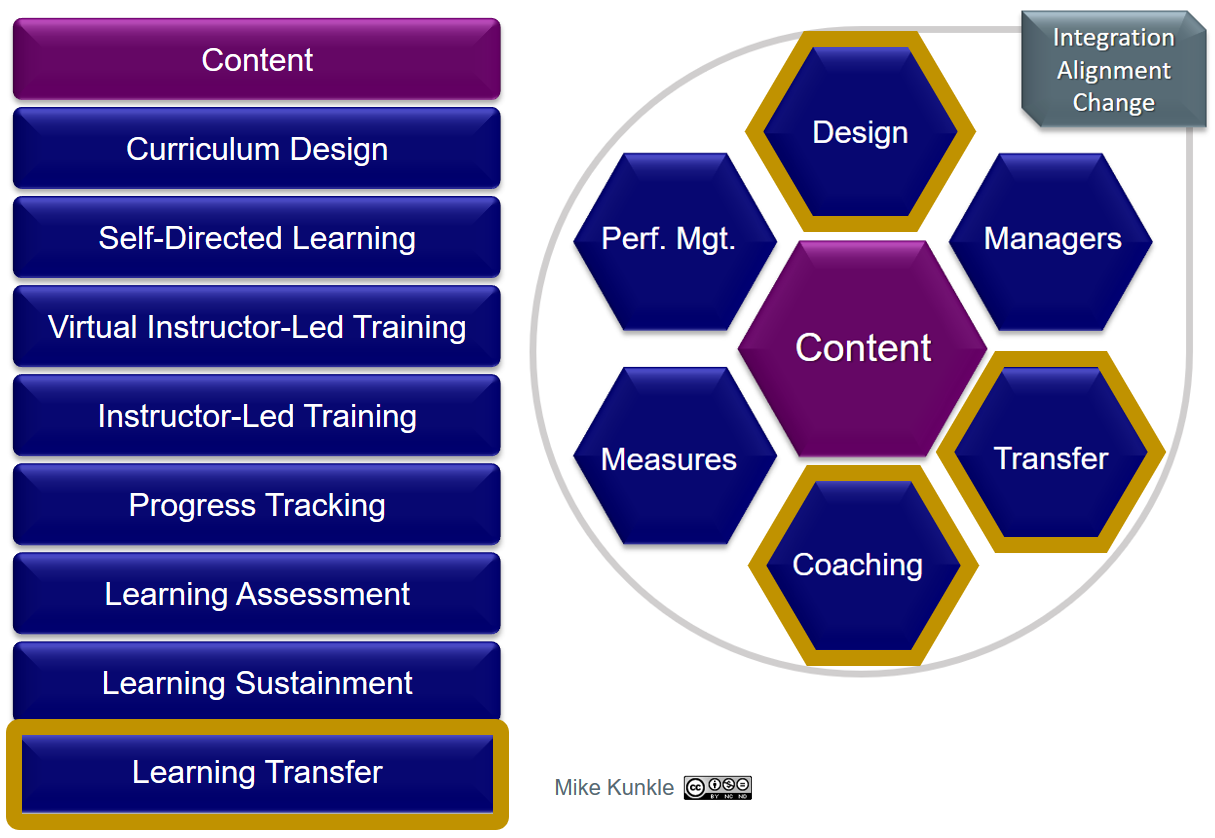
I see big gaps in this practice in many organizations, but you can create accountability for learning application with purposeful transfer activities, whether self-directed (embedded in the design of the elearning courseware) or through other standard post-course transfer activities.
This is probably best shared with an example. I’ll use elearning, since it’s less common and a frequently-cited con of that medium (high drop-out or low course-completions rates).
In one onboarding curriculum, we were teaching the knowledge and prep for appointment setting in an elearning course.
- The learners went through the content and as part of that, completed a step-by-step exercise where they built a custom script and prepared to respond to common concerns. This was based on the practices of top producers but customized for their personality and desired approach.
- At that point, the course directed them to print their completed script (generated a PDF) and meet with their manager. Their manager had been through the course and had an accompanying workbook for their guided interactions.
- The manager reviewed and adjusted or approved the script, provided accounts and leads, and sat down with the rep to observe and coach calls.
- The rep was guided to track their activity in their CRM, of course, but also on a worksheet. At the end of this activity, the rep returned to the elearning and entered their activities and results (a check box that they had met with their manager and then the number of calls, contacts, presentations, appointments set). Then, the course progressed to the next module.
This pattern repeated several times over the course, each time with reps using what they learned, manager engagement, feedback and coaching, and measurement capture. Since this simple data was in the course (LMS), we in the training department could see not only which managers were participating, but the results for each learner. Today, with interfaces, there are other ways to get the same data, but I would still do this the same way. The accountability factor for learners and managers is significant, and the benefit of the data and analysis that can be done is invaluable for training departments,.
Additional reading:
Bringing It All Together
To avoid writing an ebook (possibly too late), if you haven’t read this post yet, see this interview that Roger Courville did with me. It’s worth a read, but you can also scroll down to his “Tell me what you did” question and read from there. This is just one brief example of how to bring it all together. It worked extremely well and shows how these blended learning principles were used in a Sales Learning System to produce real-world impact and improve sales results, organization-wide. It is possible.
Additional reading:
- http://elearningindustry.com/benefits-of-synchronous-and-asynchronous-e-learning
- http://trainingtoday.blr.com/employee-training-resources/How-to-Choose-the-Most-Effective-Training-Techniques
I hope this post provides some food for thought and can be a helpful reference as you consider how to build better blended learning curricula to improve sales results.
_____________________________________________________________
As always, this is what I think. More importantly… What do YOU think?
I’d sincerely enjoy hearing your thoughts, experiences, questions, suggestions, or even disagreements or rants in the Comments section. If you enjoy this post, please feel free to share it with others. I appreciate it.
Thanks for reading, be safe out there, and by all means — let’s continue to elevate our sales profession and evolve, elevate and professionalize the Sales Enablement function.
Mike Kunkle
:: transforming sales results ::
Let’s get connected:
- Blog: http://www.transformingsalesresults.com
- LinkedIn Publisher Posts: http://bit.ly/MikeKunklePublisher
- Sales Transformation Straight Talk Webinars: http://bit.ly/STSTonSMM
- The Sales Experts Channel Webinars: http://bit.ly/SalesExpertsChannel
- LinkedIn: http://www.linkedin.com/in/mikekunkle
- Twitter: https://twitter.com/mike_kunkle
- SlideShare: http://www.slideshare.net/mikekunkle
- Google+: https://plus.google.com/u/0/+MikeKunkle
